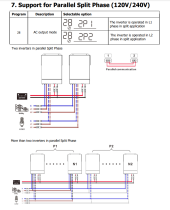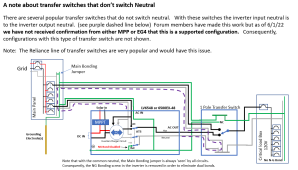I have read a lot of the other threads about this and basically understand the problem is you don't want to have a ground neutral bond in multiple places. This seems like it means that using the EG4 3kw in split phase for 240 volts would not be possible?
They show that you can use them in split phase for 240 volts though (on page 55 of the manual)
Is the problem really with having the G/N bond in the inverter and also on the panel? What if you have a transfer switch and the bond occurs on the meter and not the panel and you are not using the AC input? That would mean that you only have the G/N bond in the inverters but again it is in each inverter? Is the discussion about all these inverters that they have a fundamental flaw? Do all other inverters just expect people to do their own G/N bond in the panel?
If the G/N bond is in the panel can you simply not connect the AC output Ground wire?
There is also this section on page 17. It says when in PV/battery or standby AC output Neutral is connection to AC input ground. It then says when it is in AC mode the AC output Neutral is connected to the AC input Neutral (not ground). It doesn't talk about any of these modes anywhere in the manual. By mode do they mean the PV/battery functionality? Are they trying to imply the grounding of the unit changes on the fly as it switches from charging to providing power? Are you supposed to wire it differently depending on if you have an AC input? This "Important to Note:" is the worst part of this whole manual.

I feel like EG4 isn't a completely incompetent or evil company that would make such a terribly flawed product. Am I wrong? Do I not understand the purpose of this product?
They show that you can use them in split phase for 240 volts though (on page 55 of the manual)

Is the problem really with having the G/N bond in the inverter and also on the panel? What if you have a transfer switch and the bond occurs on the meter and not the panel and you are not using the AC input? That would mean that you only have the G/N bond in the inverters but again it is in each inverter? Is the discussion about all these inverters that they have a fundamental flaw? Do all other inverters just expect people to do their own G/N bond in the panel?
If the G/N bond is in the panel can you simply not connect the AC output Ground wire?
There is also this section on page 17. It says when in PV/battery or standby AC output Neutral is connection to AC input ground. It then says when it is in AC mode the AC output Neutral is connected to the AC input Neutral (not ground). It doesn't talk about any of these modes anywhere in the manual. By mode do they mean the PV/battery functionality? Are they trying to imply the grounding of the unit changes on the fly as it switches from charging to providing power? Are you supposed to wire it differently depending on if you have an AC input? This "Important to Note:" is the worst part of this whole manual.

I feel like EG4 isn't a completely incompetent or evil company that would make such a terribly flawed product. Am I wrong? Do I not understand the purpose of this product?








